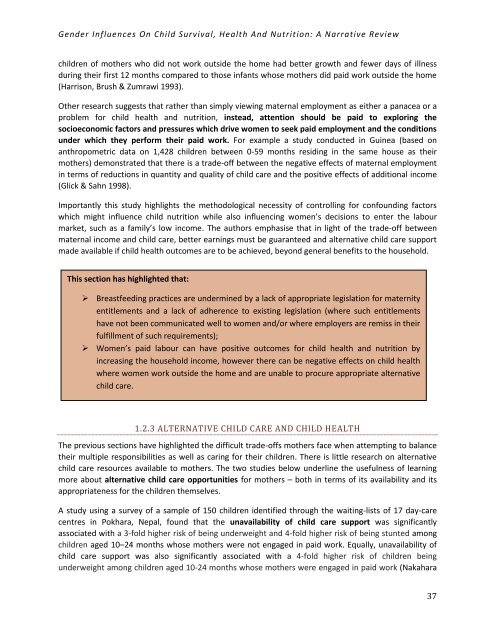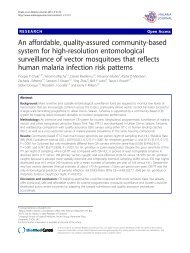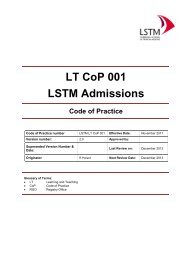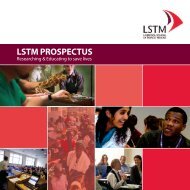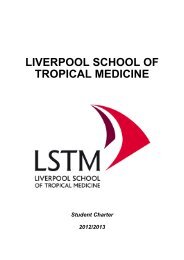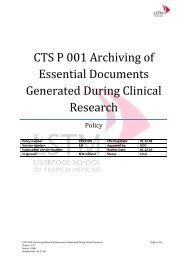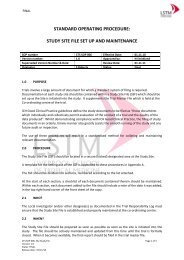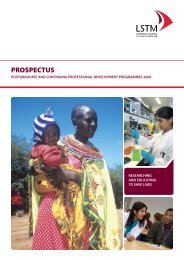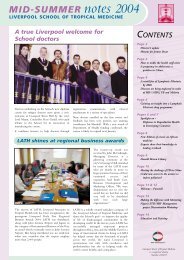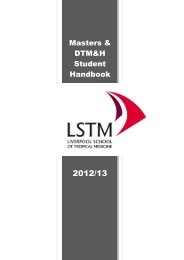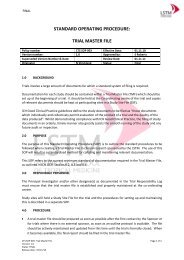Gender influences on child survival, health and nutrition: a ... - Unicef
Gender influences on child survival, health and nutrition: a ... - Unicef
Gender influences on child survival, health and nutrition: a ... - Unicef
You also want an ePaper? Increase the reach of your titles
YUMPU automatically turns print PDFs into web optimized ePapers that Google loves.
<str<strong>on</strong>g>Gender</str<strong>on</strong>g> Influences On Child Survival, Health And Nutriti<strong>on</strong>: A Narrative Review<br />
<strong>child</strong>ren of mothers who did not work outside the home had better growth <strong>and</strong> fewer days of illness<br />
during their first 12 m<strong>on</strong>ths compared to those infants whose mothers did paid work outside the home<br />
(Harris<strong>on</strong>, Brush & Zumrawi 1993).<br />
Other research suggests that rather than simply viewing maternal employment as either a panacea or a<br />
problem for <strong>child</strong> <strong>health</strong> <strong>and</strong> nutriti<strong>on</strong>, instead, attenti<strong>on</strong> should be paid to exploring the<br />
socioec<strong>on</strong>omic factors <strong>and</strong> pressures which drive women to seek paid employment <strong>and</strong> the c<strong>on</strong>diti<strong>on</strong>s<br />
under which they perform their paid work. For example a study c<strong>on</strong>ducted in Guinea (based <strong>on</strong><br />
anthropometric data <strong>on</strong> 1,428 <strong>child</strong>ren between 0-59 m<strong>on</strong>ths residing in the same house as their<br />
mothers) dem<strong>on</strong>strated that there is a trade-off between the negative effects of maternal employment<br />
in terms of reducti<strong>on</strong>s in quantity <strong>and</strong> quality of <strong>child</strong> care <strong>and</strong> the positive effects of additi<strong>on</strong>al income<br />
(Glick & Sahn 1998).<br />
Importantly this study highlights the methodological necessity of c<strong>on</strong>trolling for c<strong>on</strong>founding factors<br />
which might influence <strong>child</strong> nutriti<strong>on</strong> while also influencing women’s decisi<strong>on</strong>s to enter the labour<br />
market, such as a family’s low income. The authors emphasise that in light of the trade-off between<br />
maternal income <strong>and</strong> <strong>child</strong> care, better earnings must be guaranteed <strong>and</strong> alternative <strong>child</strong> care support<br />
made available if <strong>child</strong> <strong>health</strong> outcomes are to be achieved, bey<strong>on</strong>d general benefits to the household.<br />
This secti<strong>on</strong> has highlighted that:<br />
‣ Breastfeeding practices are undermined by a lack of appropriate legislati<strong>on</strong> for maternity<br />
entitlements <strong>and</strong> a lack of adherence to existing legislati<strong>on</strong> (where such entitlements<br />
have not been communicated well to women <strong>and</strong>/or where employers are remiss in their<br />
fulfillment of such requirements);<br />
‣ Women’s paid labour can have positive outcomes for <strong>child</strong> <strong>health</strong> <strong>and</strong> nutriti<strong>on</strong> by<br />
increasing the household income, however there can be negative effects <strong>on</strong> <strong>child</strong> <strong>health</strong><br />
where women work outside the home <strong>and</strong> are unable to procure appropriate alternative<br />
<strong>child</strong> care.<br />
1.2.3 ALTERNATIVE CHILD CARE AND CHILD HEALTH<br />
The previous secti<strong>on</strong>s have highlighted the difficult trade-offs mothers face when attempting to balance<br />
their multiple resp<strong>on</strong>sibilities as well as caring for their <strong>child</strong>ren. There is little research <strong>on</strong> alternative<br />
<strong>child</strong> care resources available to mothers. The two studies below underline the usefulness of learning<br />
more about alternative <strong>child</strong> care opportunities for mothers – both in terms of its availability <strong>and</strong> its<br />
appropriateness for the <strong>child</strong>ren themselves.<br />
A study using a survey of a sample of 150 <strong>child</strong>ren identified through the waiting-lists of 17 day-care<br />
centres in Pokhara, Nepal, found that the unavailability of <strong>child</strong> care support was significantly<br />
associated with a 3-fold higher risk of being underweight <strong>and</strong> 4-fold higher risk of being stunted am<strong>on</strong>g<br />
<strong>child</strong>ren aged 10–24 m<strong>on</strong>ths whose mothers were not engaged in paid work. Equally, unavailability of<br />
<strong>child</strong> care support was also significantly associated with a 4-fold higher risk of <strong>child</strong>ren being<br />
underweight am<strong>on</strong>g <strong>child</strong>ren aged 10-24 m<strong>on</strong>ths whose mothers were engaged in paid work (Nakahara<br />
37


